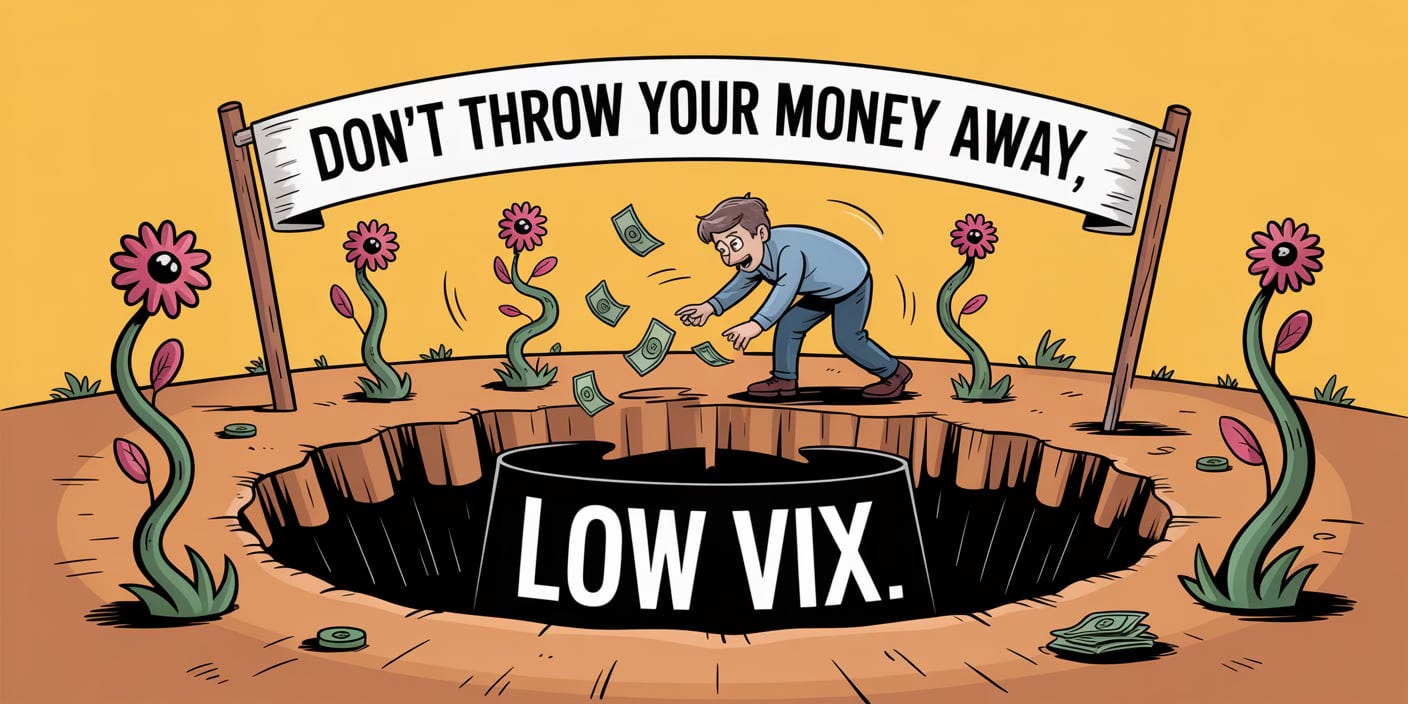At first glance, buying the VIX when it’s “low” seems like a smart play. After all, the VIX — often called Wall Street’s “fear gauge” — averages around 19–20 over the long term. If it drops to 12–14, shouldn’t it mean-revert higher?
Not exactly. Many traders have learned the hard way that simply buying VIX calls or ETFs when the index looks “cheap” is usually a losing strategy. Here’s why.
The Problem with “Cheap” VIX
Low can stay low for a long time. The VIX can sit between 10–15 for months or even years in strong bull markets.
You don’t trade the spot VIX. Options and ETFs track VIX futures, which don’t always move in sync with the index.
Decay is constant. VIX futures products suffer from contango drag, and VIX options lose value from time decay while you wait.
Without a timing catalyst, “cheap VIX” is often a mirage.
Three Common Scenarios That Trap Traders
Scenario 1: The Endless Wait
You buy VIX calls when VIX = 14 (“historically low!”).
The market stays strong, and the VIX chops between 12–16 for the next 8 months.
Your calls expire worthless despite the VIX looking “cheap.”
Lesson: The VIX can remain low much longer than you can stay solvent.
Scenario 2: The Futures Trap
Spot VIX = 16, you buy VIX calls.
But your calls are based on 30-day VIX futures, which are trading at 19.
The VIX spikes to 22 on breaking news, but futures only rise to 21.
Your calls barely move despite being “right” on direction.
Lesson: You’re not trading the spot VIX — futures matter.
Scenario 3: The Timing Miss
VIX = 13, you buy 3-month calls.
For 2.5 months, the market stays calm, and time decay eats your premium.
Two weeks after expiration, the VIX finally spikes to 28.
You were right on the move but wrong on timing — and lost money.
Lesson: Being early is the same as being wrong when decay is constant.
Advanced Alternatives to Blindly Buying the VIX
If buying the VIX just because it’s low is a losing game, what should sophisticated traders do instead? The key is understanding futures structure, options decay, and event-driven volatility. Here are advanced approaches:
1. Call Spreads Instead of Naked Calls
Instead of buying outright VIX calls (which bleed value from time decay), buy a vertical call spread.
Example: With VIX futures at 15, buy the 17.5 call and sell the 22.5 call.
This caps your upside but significantly reduces premium cost and decay risk.
Why it works: You’re betting on a reasonable spike while lowering the time-decay drag that ruins naked calls.
2. Event-Driven Volatility Plays
Volatility doesn’t spike randomly — it spikes around events (earnings, Fed meetings, geopolitical shocks).
Advanced traders only initiate long vol positions ahead of catalysts, not just because “VIX looks low.”
Example: Buy call spreads a week before FOMC or elections, close them as IV expands into the event.
Why it works: You’re trading the expectation of movement, not just the level of VIX.
3. Calendar or Diagonal Spreads
When front-month IV is cheap, but longer-term IV is elevated, use calendar spreads (sell front-month, buy back-month).
Example: Sell 1-month 20 call, buy 2-month 20 call.
You benefit if near-term vol stays muted but expect a longer-term catalyst to push volatility higher.
Why it works: Exploits differences in the VIX term structure instead of just betting on direction.
4. Ratio Spreads in Low VIX Environments
In low IV regimes, advanced traders sometimes sell more options than they buy.
Example: Buy 1 VIX call at 17.5, sell 2 calls at 22.5.
Small spikes bring profit, while large spikes require careful risk management.
Why it works: Takes advantage of rich premiums in OTM calls while maintaining cheap upside exposure.
5. Monitor Term Structure (Contango vs. Backwardation)
When the VIX is low but the futures curve steepens in contango, long vol trades are money-losers.
Advanced traders wait until the curve flattens or goes into backwardation before taking long volatility exposure.
Why it works: Futures structure dictates returns more than spot VIX levels.
Key Takeaways
Don’t just “buy low” — use defined-risk spreads instead of naked calls.
Anchor trades to events and catalysts.
Exploit term structure with calendar spreads or contango/backwardation analysis.
Hedge equities with volatility, instead of trading it in isolation.
Remember: Buying vol is easy, holding it profitably is hard. Advanced traders define risk, reduce decay, and focus on timing.
Bottom Line: Successful volatility trading isn’t about guessing when the VIX will rise. It’s about structuring trades so that when it does rise — whether from a catalyst or a shock — your positions pay off without bleeding away while you wait.



